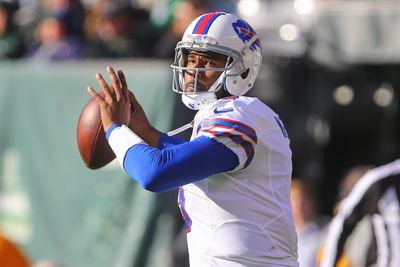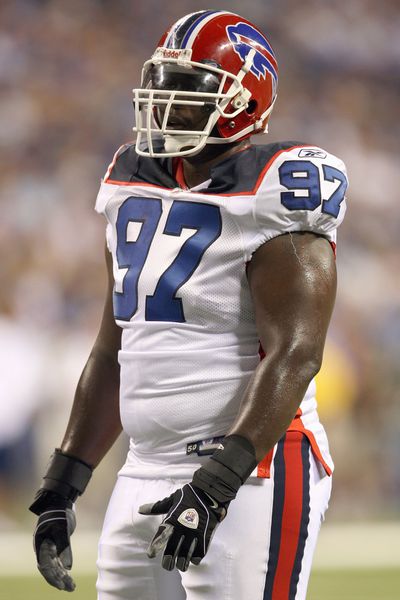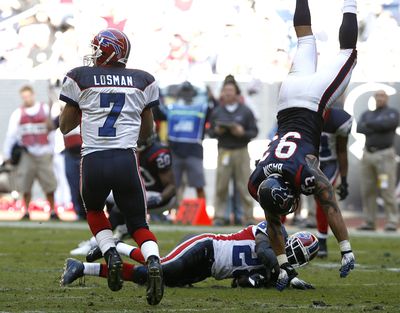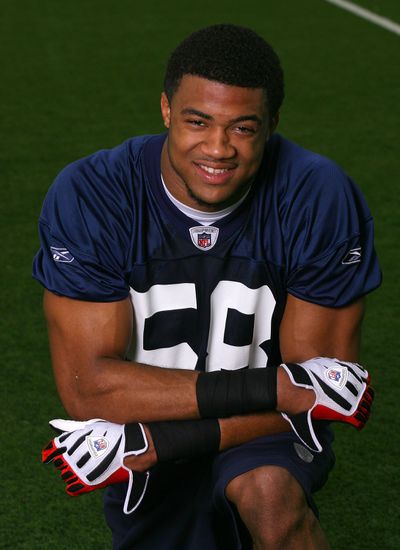
QB misfires, overzealous drafting and poor management has led to plenty of mistakes in the last 25 years.
Mistakes were made. Before general manager Brandon Beane took over things with the Buffalo Bills, every draft was akin to tiptoeing in a minefield. It seemed as though the team always managed to pick the one player out of 10 drafted around him who didn’t have a Hall of Fame career — or Buffalo traded up for player who was supposed to be generational but never quite met the hype.
Just over a day until the 2025 NFL Draft, why not revisit some of those 21st century mistakes? There are of course many options for this list, but I’ve narrowed it down to five and kept it to players taken in the first round — even though the 2011 trade up for wide receiver T.J. Graham could easily be included.
Ready? Hang on!
5. RB C.J. Spiller (9th Overall Pick in 2010)

Photo by Ronald C. Modra/Getty Images
C.J. Spiller lands here both for his production (or lack thereof) with the Bills and the decision to draft him here in the first place. The Bills took Spiller ninth overall despite having 2007 first-round pick Marshawn Lynch on the roster (who had back-to-back 1,000 yard seasons before getting injured in 2009), and Fred Jackson (who posted 1,400 yards from scrimmage in Lynch’s absence).
Buffalo seemed set at running back and drafting Spiller just muddied the position and failed to address the team’s real problems, especially on defense. The Bills might’ve shorted the trade market for Marshawn Lynch as well, garnering only a fourth- and fifth-round pick from the Seattle Seahawks for a running back in his prime in an era when the position was still a huge focus.
Buffalo had less leverage with Spiller on the team as they were more eager to move Lynch and couldn’t wait for a better deal to come along. The pick also looks worse in hindsight with five Pro Bowl talents being drafted in the 10 picks following Spiller, including Earl Thomas, Jason Pierre-Paul and Brandon Graham.
Spiller struggled to live up to his draft status, especially his first two seasons where he accumulated just 800 rushing yards and eight total touchdowns. He played second fiddle to Fred Jackson for all of 2010 and kept that role until Jackson suffered a knee injury in the middle of his impressive 2011 campaign. Spiller was able to top 100-plus yards from scrimmage in four of the team’s final six games while filling in for Jackson and looked poised to finally breakout.
That breakout did come in 2012, with Spiller notching 1,703 total yards, eight total touchdowns and a yards-per-carry average of 6.0 that stands as a top ten mark all-time and tied him with Adrian Peterson during his historic MVP season. He was named a Pro Bowl alternate, replacing Ray Rice and seemed to have finally reached featured back status. Spiller was an electric playmaker and it felt like he hadn’t yet reached his full potential, ranking eighth in total rushing yards with just 207 carries on the season (22nd in the league).
After a promise from then-offensive coordinator Nathaniel Hackett to “give him the ball until he throws up” it seemed cemented that the backfield belonged to Spiller. But that never manifested itself. Instead, Spiller’s usage and production were spotty as he tallied just four games with 20-plus touches and ran for under 1,000 yards despite receiving a near-identical amount of carries as the year prior (202).
Jackson and Spiller split the backfield in half and led Buffalo to the second-best rushing offense in the league, but it was a far cry from the ascent to superstardom fans expected. Spiller’s 2014 season was even worse, with a season-high rushing mark of just 69 against the Miami Dolphins in Week 2 and a collarbone injury in Week 7 after a just one carry that went for 53 yards. He would play just nine games in 2012 and match his career low in yards per carry (3.8).
Since Buffalo was able to sign Spiller to a five-year contract after the 2010 draft, they didn’t have to make a decision to pick up a fifth-year option or extend him following his best season in 2012, which allowed the team to let Spiller go to free agency in the 2015 offseason. The New Orleans Saints would sign him to a four-year, $18 million contract but he would only last one season in The Big Easy and was out of the league after three nearly invisible stops with the Seattle Seahawks, New York Jets and Kansas City Chiefs between 2016 and 2017.
Positional value and an already talented backfield made Spiller a bad pick the moment he was drafted. Buffalo barely got to reap the rewards of a running back on a rookie contract, getting a single season of 1,000-plus yards and no consistency from a player who should have been a slam dunk.
4. QB EJ Manuel (16th Overall Pick in 2013)

Photo by Ed Mulholland/Getty Images
Oh EJ Manuel, how we all wished you were the answer at quarterback. The first QB taken in 2013, Manuel was another pick that was immediately questioned at the time he was taken, with most draft analysts grading him as a second= or third=round prospect.
Buffalo had released quarterback Ryan Fitzpatrick due to a bloated contract, instead looking to move forward with a young signal caller in what was deemed (and proven) a historically bad QB draft class. Holding the eighth overall pick, the Bills opted to trade back in Round 1, grabbing picks 16, 46 and 222 from the then-St. Louis Rams to draft Manuel with pick 16.
Grabbing extra compensation softened the blow on reaching for Manuel as linebacker Kiko Alonso was selected at 46 and later traded for running back LeSean McCoy — which was a big net-positive for the team down the line. The issue is that Manuel was treated like a surefire prospect rather than a project QB. The team had no truly proven veteran competition to challenge him, with Thad Lewis and Jeff Tuel the only other quarterbacks rostered.
EJ Manuel had his moments, most notably the comeback win/last-second touchdown against the Carolina Panthers in Week 2 of 2013 where he connected with wide receiver Stevie Johnson in the corner of the end zone for his first win as a pro. That game would be the peak for Manuel’s rookie year, with a season high in passing yards (296) and the memorable game-winner.
Manuel had five touchdowns to four interceptions and a 2-2 record before getting hurt in a Week 5 game against the Cleveland Browns. Buffalo’s offense felt flat with Manuel at the helm and while he showed strong poise for a rookie at times, he lacked any pop factor that you would expect from a first-round QB.
Following his five-game absence, Manuel took back the starting job and went 2-3 with six touchdowns and six interceptions. His injury reappeared with knee swelling in Week 16, which ended his season after starting just 10 games.
Manuel was seen as the starting QB going into 2014 but never cemented himself as the franchise’s answer during his rookie year. Those leg injuries he sustained took away valuable learning experience and never seemed to allow him to transcend beyond a quarterback struggling to break free of a maddening “too-safe” play style.
The following season, veteran Kyle Orton was brought in a week before the regular season to put pressure on Manuel to perform. The motivation didn’t work. The Bills would start 2-0 but it was more in spite of Manuel, who was operating as a game manager, throwing just 48 times through two weeks for a combined 398 yards and two touchdowns.
The next two games failed to hide Manuel’s flaws, as the offense only mustered 10 and 17 points in losses. Week 4 in Houston was highlighted by J.J. Watt’s 80-yard pick-six of Manuel, who averaged 5.1 yards per attempt and threw two interceptions. Head coach Doug Marrone made the switch to Orton after this game and didn’t look back. The defense was too good to squander and wait for Manuel to figure it out and Orton would start the remaining of the season, leading Buffalo to their first winning record in a decade.
After 2014, Marrone notoriously resigned and Orton retired, leaving Manuel with a fresh start but also less front-office loyalty. Rex Ryan allowed Manuel to compete with Tyrod Taylor and Matt Cassel ahead of the 2015 season but, Manuel quickly plummeted to third string quarterback on the depth chart.
Taylor was named as the starter but Manuel did step in for him due to injury for two games, both losses — and he was just as inconsistent and turnover-prone as in prior seasons. Once healthy, Taylor regained the job and Manuel was only given time on the field to hard-count the defense or run an occasional QB sneak.
Buffalo declined Manuel’s fifth-year option in 2016 and his last action in a Bills uniform was during a meaningless Week 17 matchup, in which he was benched for Cardale Jones. Manuel is a case of a bad pick the team forced itself into out of need. While many Bills QBs were worse during the drought, none were more doomed from the start than EJ Manuel.
3. DT John McCargo (26th Overall Pick 2006)

Photo by Jonathan Daniel/Getty Images
Finally a much shorter and less nuanced saga of a failed Bills first rounder. John McCargo wasn’t a prospect with a first-round grade coming out of North Carolina, with many experts seeing him as someone who reaped the benefits of future Bills edge rusher Mario Williams.
Buffalo had selected safety Donte Whitner eighth overall and decided to outbid themselves by trading back into Round 1 to draft McCargo at 26 (a genuinely bad trade for their trade partner, the Chicago Bears, which sent a first-round pick for a second and third rounder. I bet that gets laughed away by any GM today).
McCargo broke his foot as a rookie and was limited to five games played. He was a backup in 2007 but managed to notch 2.5 sacks — the only sacks of his career — and 29 of his 52 career tackles. The bust label was already in action at this point however, as Buffalo was starting another 2006 draftee, fifth-round pick Kyle Williams over McCargo.
Infamously in October 2008, the Bills traded McCargo to the Indianapolis Colts but a failed physical voided the trade and put him back on Buffalo’s roster. Despite the attempted trade, McCargo played out his full rookie contract, appearing in 14 more games for Buffalo between 2008-2010.
While he was considered a reach and a bad pick at the time, McCargo’s complete invisibility in five seasons really defined the mismanagement of the 2000s Bills. The failed trade-and-draft is a cherry on top. He was never an off-field issue and seemed to take his poor reputation better than most, but McCargo never came close to being worth a first-round pick.
2. QB J.P. Losman (22nd Overall Pick in 2004)

Photo by Bob Levey/NFLPhotoLibrary
The sweet prince we were promised, now 20(!) years removed. J.P. Losman’s five-year Bills tenure was messy and frustrating. The first quarterback taken by Buffalo in the first round since Jim Kelly, Losman was seen as a raw but athletically talented quarterback and was intended to be Drew Bledsoe’s successor.
Losman was the fourth QB taken in Round 1 of the 2004 NFL Draft, behind Eli Manning, Phillip Rivers, and Ben Roethlisberger. The major success of those three puts an extra sting on Losman’s story, but Buffalo really only had a realistic chance to draft Roethlisberger who was taken 11th.
Losman’s rookie season was supposed to unfold as a learning role behind Bledsoe, but a practice collision with now EVP of NFL Operations Troy Vincent resulted in Losman breaking his leg and missing two months of action. He attempted just five passes in 2004, but was set to take over as a starter after Bledsoe’s release the following offseason.
The Bills won Losman’s first start against the Houston Texans, 7-2, where he threw his first career touchdown pass. Unfortunately, his season immediately derailed after that game. Over the next three weeks, Losman would go a combined 28-of-66 for 263 yards and zero touchdowns to one interception. He was promptly benched for backup quarterback Kelly Holcomb.
Losman appeared lost and Buffalo’s offense was rudderless but the benching was made in haste and started a trend where Losman never got a true vote of confidence from Bills coaches or management. He would fill in for Holcomb and lead Buffalo to a 14-3 win over Kansas City, but Buffalo would lose Losman’s next four starts — and even his best game (225 yards and 3 TDs) against Miami in Week 13 came in a loss where the Bills choked a 23-3 lead in the second half. Holcomb finished as the starter for the final three weeks of 2005 and Buffalo fired head coach Mike Malarkey after a 5-11 season.
With Marv Levy back in the Queen City as general manager and Dick Jauron as the new head coach, Losman had to fight for his job in the preseason. He went on to have a much-improved 2006 where he showed off a bit of the potential he had coming out of college.
His completion percentage went from 49.6% to 62.5% and Losman was able to play all 16 games, throwing a touchdown in all but three contests. Losman’s raw numbers turned the corner but Buffalo’s offense was still putrid overall — not at all helped by a bottom-five rushing offense and league-worst third-down-conversion percentage. Losman was also sacked 47 times, third most in the NFL. He wasn’t setting the world on fire but it felt like Losman had earned his keep after such a tumultuous first two seasons.
Buffalo would once again show a public lack of faith in Losman by taking quarterback Trent Edwards in the 2007 draft after Edwards endured a notable slide from first-round consideration to becoming the Bills’ third-round selection. Losman was given the starter role going into the 2007 NFL season but after an 0-2 start with no touchdown passes, it appeared he regressed back to the 2005 version of himself.
He was then injured after one pass against the New England Patriots in Week 3 and Edwards started the next three games in his stead. When Losman was healthy again, Edwards retained the job. This decision was highly controversial and reportedly to prevent Losman from cashing in on contract bonuses.
Losman would regain the starting role after Edwards was injured, and Losman led Buffalo to three straight wins and a 5-4 record. The team subsequently lost by a combined 68 points over the next two weeks and Losman was benched for good, putting up just three touchdowns in his six full starts of 2007. Losman’s agent made it known the QB wanted to be traded and put the Bills on blast for their lack of a support system and poor management around the former first-round draft pick.
Buffalo didn’t move Losman and he saw playing time in five games of the 2008 NFL season while replacing an injured Edwards. Losman was again ineffective and the Bills lost every game where he was involved. This wound up being Losman’s last year with Buffalo and he never started another NFL game.
While Losman never truly proved worthy of franchise quarterback status, the organization’s lack of “all in” on Losman no doubt made his saga a toxic tale. The Bills’ brass never built much of a talented offensive roster around their highly drafted QB and they made him feel like he always had to look over his shoulder, whether metaphorically due to competition, or literally because he was about to be sacked.
Taking everything that unfolded around him with as much grace and professionalism as you could ask for, Losman dealt with two coaching/management regimes and three different offensive coordinators. His career serves as a prime example on how not to nurture a young QB, especially when considering the success of his 2004 draftee contemporaries.
1. EDGE Aaron Maybin (11th Overall Pick in 2009)

Photo by Rick Stewart/Getty Images
Aaron Maybin’s Bills story carries massive weight in Western New York, even though his tenure was quite short and unremarkable. Maybin was an impressive prospect as a speed rusher coming out of Penn State, but Buffalo was seen as reaching when they took him 11th overall.
Three future Pro Bowl-level defenders in Brian Orakpo, Malcolm Jenkins and Brian Cushing were taken with three of the four pick after Maybin. Similar to John McCargo, Maybin just never had what was needed at the NFL level. Maybin provided no glimmer of hope that he was worth his draft status.
Buffalo never listed Maybin as a starter in any game during his rookie season, despite having played all 16 games and recording 18 tackles but also no sacks and zero QB hits. For a pass rusher who was supposed to be an athletic freak, Maybin’s inability to earn proper reps was incredibly disappointing and almost unheard of from a first rounder.
His name soured with Bills Mafia quickly and in 2010 Maybin was barely able to see the field again, finding himself a healthy scratch halfway through the season as Buffalo’s coaches saw that he wasn’t good enough. This was also a bottom-five Bills defense, so it should have been in the team’s interest to try and develop a young pass rusher. But Maybin didn’t prove anything in practices or in sparse game action. Buffalo would let Maybin stick around for one more training camp in 2011 before waiving him during the preseason.
There was never a question about Maybin’s time off-field or his character. Instead, everything that went wrong was strictly related to football performance. That’s what makes his failure so epically perplexing.
Maybin found the ire of Buffalo when he signed with the Jets in 2011 and immediately performed like an NFL-caliber talent, notching six sacks in 13 games after having none in his Bills career. That stint however, was also short-lived as the Jets stifled his playing time and cut Maybin the following season. He would never again play an NFL down.
But wait, there’s more…
Sammy Watkins, Mike Williams, Kaiir Elam and maybe even Sammy Watkins (who was productive when on the field) may all be worthy of consideration here. These five players above stick out to me like the sore thumb of impact their draft bust status revealed.
Interestingly, none of the players above had any character issues that fed into their shortcomings. It was either bad football operations leading to failed development or just a natural lack of professional talent, which is more of the team/scouting department’s fault for failing to notice.
Each of these players are a reminder of where Buffalo Bills football use to be, a doldrums of poor decision making and impatience that culminated in wasting players talent and led to a 17 year long drought. Buffalo’s come a long way these last eight years.